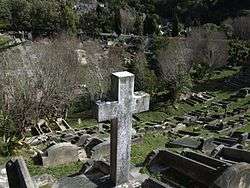Karori Cemetery
Karori Cemetery is New Zealand's second largest cemetery, located in the Wellington suburb of Karori.
 View of Karori Cemetery | |
| Details | |
|---|---|
| Established | 1891 |
| Location | |
| Country | New Zealand |
| Owned by | Wellington City Council |
| Website | Wellington City Council entry for Karori Cemetery |
| Footnotes | cemeteries database |
History
Karori Cemetery opened in 1891 to address overcrowding at Bolton Street Cemetery.
In 1909, it received New Zealand's first crematorium, which is still in use and is Australasia's oldest.
Karori Cemetery reached capacity during the 1950s, and Makara Cemetery became Wellington's main burial ground. Burials at Karori happen only in pre-purchased family plots, in children's plots, and in pre-purchased ash plots.[1]
The Karori Crematorium and Chapel are listed (Class I) with the New Zealand Historic Places Trust.
Description
The cemetery covers almost 40 hectares (0.40 km2) and has seen more than 83,000 burials.[2]
War graves
The cemetery contains separate World War I and World War II services sections. Buried here are 268 Commonwealth service personnel of World War I[3] – including most deaths from the first New Zealand Expeditionary Force Reinforcement Camp and others at Trentham, and the Upper Hutt Remount Depot[4] – and 123 of the World War II, besides a Norwegian and a French war casualty.[3]
The Commonwealth War Graves Commission (CWGC) also erected a plaque commemorating 15 New Zealand service personnel of World War II who were cremated at Karori Crematorium and their ashes scattered. It is set into the Services Columbarium Wall in the Services section.[5]
In addition, the CWGC erected the Wellington Provincial Memorial, in the form of a marble arch connecting the two Services sections, inscribed with the names of service personnel from Wellington Province who died serving in the World Wars but have no known grave.[3]
Burials
- Suzanne Aubert the saint founder of the Daughters of Our Lady of Compassion (later translated to the motherhouse of the religious institute
- Albert Henry Baskerville (1883–1908), Organiser of the famous All Golds tour to Great Britain and Australia[6]
- William Thomas Beck (1865–1947), New Zealand Army officer and one of the first New Zealanders to land on Gallipoli on 25 April 1915
- John Duthie (1841–1915), businessman and politician, including Mayor of Wellington (1889–1890)
- Peter Fraser (1884–1950), Prime Minister (with memorial)
- John Hosking (1854–1928), judge of the Supreme Court[7]
- Joseph Kinsey (1852–1936), businessman, collector, and philanthropist from Christchurch[8]
- Charles Morison (1861–1920), New Zealand barrister[9]
- Mary Player (c. 1857 – 1924), servant, midwife, welfare worker, feminist and social reformer[10]
References
- "About Karori Cemetery". Wellington City Council. Retrieved 11 April 2014.
- "Karori Cemetery". Wellington City Council. Retrieved 11 April 2014.
- "Wellington (Karori) Cemetery". Commonwealth War Graves Commission. Retrieved 16 December 2016.
- "Trentham (St John's Anglican) Churchyard". Commonwealth War Graves Commission. Retrieved 16 December 2016.Incidental information from Trentham Churchyard CWGC web page, not given on Karori Cemetery's.
- "Wellington (Karori) Crematorium". Commonwealth War Graves Commission. Retrieved 16 December 2016.
- "The All Golds". Archived from the original on 2017-10-10. Retrieved 2020-02-13.
- "Obituary". The Press. LXIV (19324). 31 May 1928. p. 10. Retrieved 25 September 2015.
- "Late Sir J. Kensey". The New Zealand Herald. LXXIII (22413). 8 May 1936. p. 12. Retrieved 25 March 2016.
- "Details". Wellington City Council. Retrieved 4 February 2015.
- Millen, Julia. "Mary Josephine Player". Dictionary of New Zealand Biography. Ministry for Culture and Heritage. Retrieved 6 August 2015.